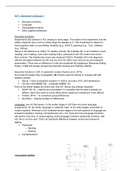HC7: Alzheimer’s Disease 2
Executive functions
Language
Visuospatial functions
Early cognitive predictors
Executive functions
Impairments are common in AD, already in early stage. The extent of the impairment and the
pattern depends very much on which stage the disease is in. The impairment is relative to
neurocognitive tests on set shifting, flexibility (e.g., WCST), planning (e.g., ToL), inhibition
(e.g., Stroop).
Stroop in AD (Bondi et al. 2002): 51 healthy controls, 59 probable AD. In all conditions (word
reading, color reading, color-word reading trials), participants with AD made more errors
than controls. The interference score was impaired (CW/C). Probable AD is the diagnosis
with the strongest evidence for AD, but you can’t be 100% sure until you do your research
postmortem. There was no difference in mild and moderate AD subgroups (Dementia Rating
Scale) Mild AD already showed psychomotor slowing and inhibitory deficits.
Executive functions in AD: A systematic review (Guarino et al. 2019).
Out of the 45 studies they investigated, 30 of those used the Stroop to compare AD with
healthy controls.
Stroop = most consistently impaired both in accuracy, RTs, and interference
AD very mild (MMSE 26) – moderate (MMSE 16)
Even at the earlier stages and there was mild AD, Stroop was already impaired!
WCST (N=14) – deficits are inconsistent: it is possible that the task is already too
difficult, that’s why there is a floor effect which makes the comparison more difficult.
Flanker (N=4) – no consistent group differences
Go-NoGo – majority studies no differences
Language: are not that severe. In the earlier stages in AD there are some language
impairments. On the whole, language is relatively intact. In the early stages: production is
mostly impaired. Whereas in the moderate-severe stages a lot more aspects of language are
impaired (repetition, naming, comprehension etc.). So, more and more language functions
will decline over time. In normal ageing, some language functions ameliorate overtime, with
AD, this is not the case. That’s an important difference between normal and abnormal
ageing.
Production
o Naming
o Fluency
Comprehension
Visuospatial abilities
, Impairments are typically mild in early stages. Become more and more severe with the
progression of the disease. A task which is very popular for visuospatial abilities is the visual
search: feature vs. conjunction search. The AD group is slower than HC, even in feature
search. The impairments are more severe in more advanced AD.
Mental rotation: mentally rotate the figure to
upright position and tell on which side of the
figure the ball will be. The AD group is slower
to respond (mentally rotate). The accuracy is
also slower in AD patients, greater decline
with increasing angles.
A very popular task is the clock drawing task. You have to draw a clock from memory, copy
clock. The errors in the AD group are mainly conceptual errors, e.g.,: drawing clock
without numbers or without hands and setting time (10 past 11) incorrectly. In more
advanced stages, there is very abnormal clock drawing. Mostly conceptual errors – deficit
accessing knowledge.
Visual Object and Space Perception (VOSP): 31 AD, 44 HC (Quental et al. 2013). The early-
stage AD were impaired on most of the tasks in this battery (subtests of object perception
and space perception).
Potential causes visuospatial disorders (Cronin-Golomb, 2011)
Reduced contrast sensitivity
Reduced motion perception (optic flow)
Inadequate scanning of visual field
Attention/neglecting part of visual field
Pattern neuropsychological impairments. On all of
them there are at least some impairments, the
severity differs depending on which stage the AD
is in. There is a typical pattern memory and EF
impairments in early-stage AD.
What you see here: in an early stage the disorders
are relatively selective (grey is not impaired, black
is impaired). Over time, it gets less selective, and
more and more functions start to decline. For
example, more and more language functions
decline. The typical pattern is therefore less distinctive when the AD progresses, because
other disorders start to rise. This is why
it is harder to distinguish different types
of dementia, because the typical
pattern gets more unclear.
Important: the severity and the profile of
the cognitive disorder varies per age on
which the diagnosis is set: a diagnosis
at an early age fits another profile than
a diagnosis at a later age. Why is that?




